PostgresML Tutorial: Doing Machine Learning With SQL
The prevailing trend in machine learning involves transferring data to the model's environment for training. However, what if we reversed this process? Given that modern databases are significantly larger than machine learning models, wouldn't it be more efficient to move the models to the datasets?
This is the fundamental concept behind PostgresML – the data remains in its location, and you bring your code to the database. This inverted approach to machine learning offers numerous practical advantages that challenge conventional notions of a "database."
PostgresML: An Overview and its Advantages
PostgresML is a comprehensive machine learning platform built upon the widely-used PostgreSQL database. It introduces a novel approach called "in-database" machine learning, enabling you to execute various ML tasks within SQL without needing separate tools for each step.
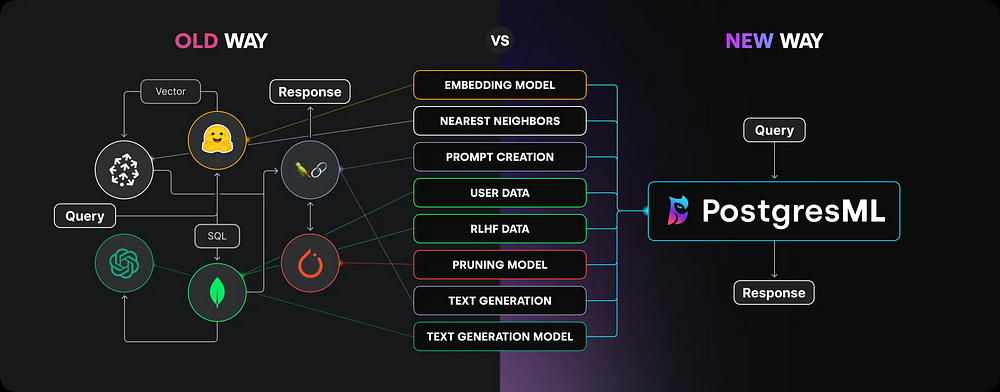
Despite its relative novelty, PostgresML offers several key benefits:
- In-database ML: Trains, deploys, and runs ML models directly within your PostgreSQL database. This eliminates the need for constant data transfer between the database and external ML frameworks, enhancing efficiency and reducing latency.
- SQL API: Leverages SQL for training, fine-tuning, and deploying machine learning models. This simplifies workflows for data analysts and scientists less familiar with multiple ML frameworks.
- Pre-trained Models: Integrates seamlessly with HuggingFace, providing access to numerous pre-trained models like Llama, Falcon, Bert, and Mistral.
- Customization and Flexibility: Supports a wide range of algorithms from Scikit-learn, XGBoost, LGBM, PyTorch, and TensorFlow, allowing for diverse supervised learning tasks directly within the database.
- Ecosystem Integration: Works with any environment supporting Postgres and offers SDKs for multiple programming languages (JavaScript, Python, and Rust are particularly well-supported).
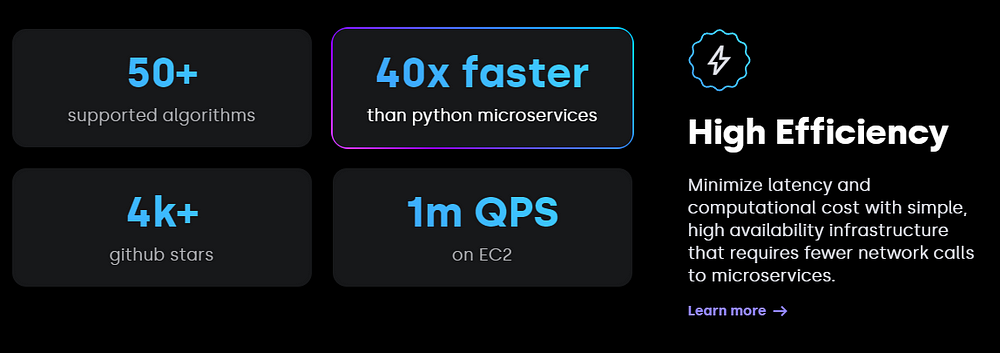
This tutorial will demonstrate these features using a typical machine learning workflow:
- Data Loading
- Data Preprocessing
- Model Training
- Hyperparameter Fine-tuning
- Production Deployment
All these steps will be performed within a Postgres database. Let's begin!
A Complete Supervised Learning Workflow with PostgresML
Getting Started: PostgresML Free Tier
- Create a free account at https://www.php.cn/link/3349958a3e56580d4e415da345703886:
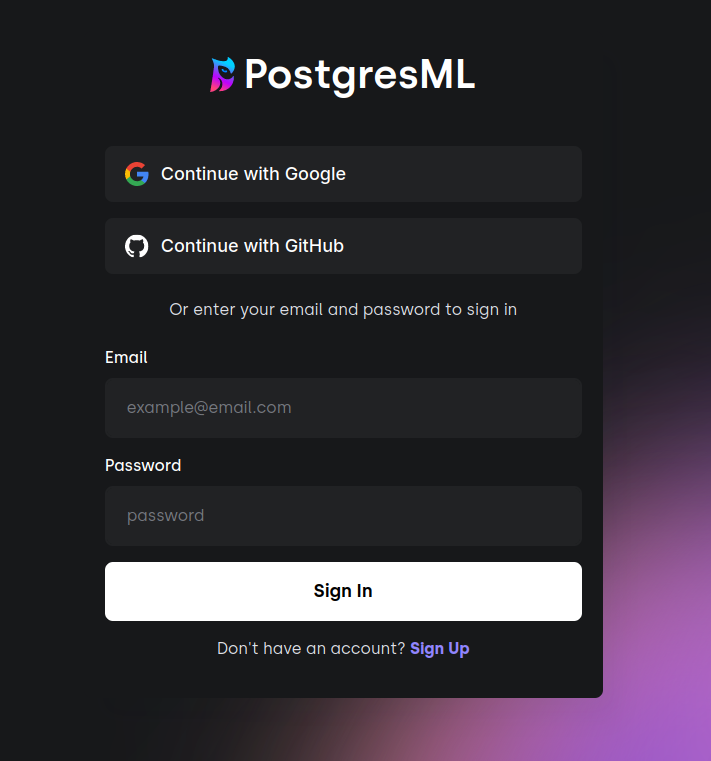
- Select the free tier, which offers generous resources:

After signup, you'll access your PostgresML console for managing projects and resources.
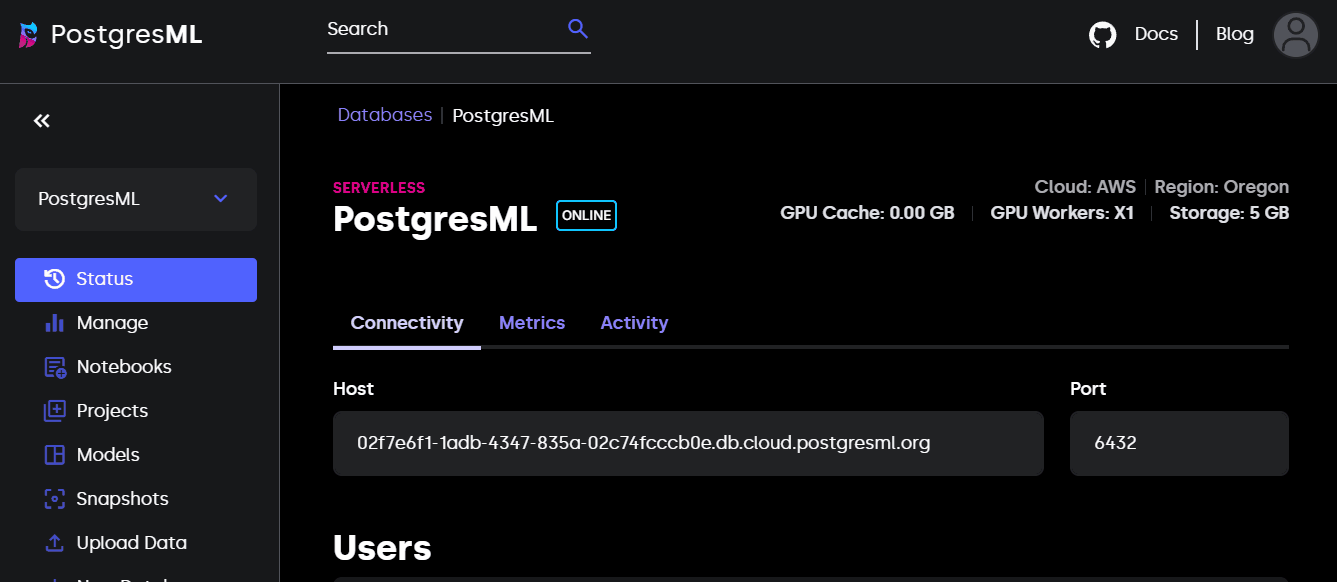
The "Manage" section allows you to scale your environment based on computational needs.
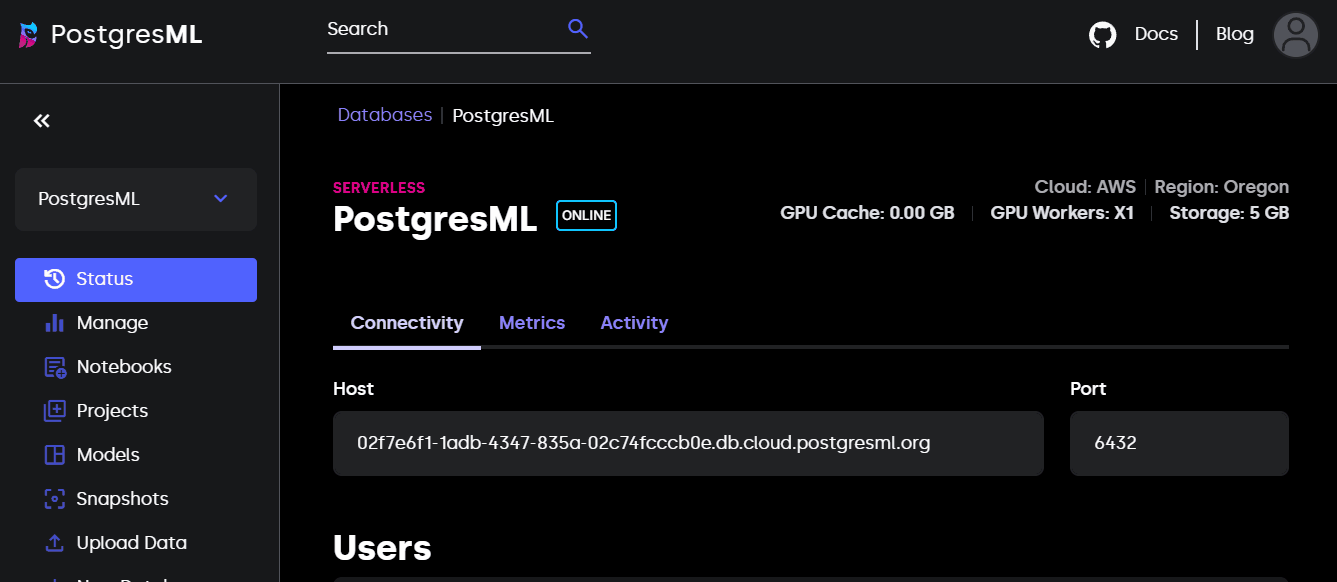
1. Installing and Setting Up Postgres
PostgresML requires PostgreSQL. Installation guides for various platforms are available:
- Windows
- Mac OS
- Linux
For WSL2, the following commands suffice:
1 2 3 4 |
|
Verify the installation:
1 |
|
For a more user-friendly experience than the terminal, consider the VSCode extension.

2. Database Connection
Use the connection details from your PostgresML console:
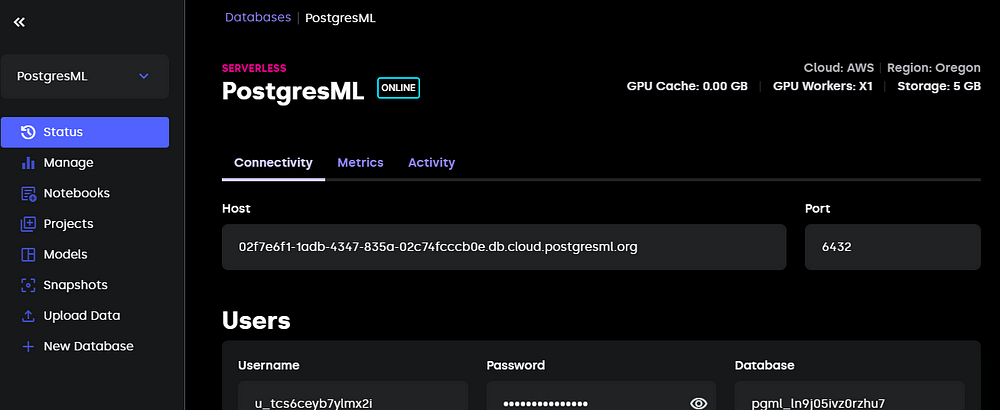
Connect using psql:
1 |
|
Alternatively, use the VSCode extension as described in its documentation.
Enable the pgml extension:
1 |
|
Verify the installation:
1 |
|
3. Data Loading
We'll use the Diamonds dataset from Kaggle. Download it as a CSV or use this Python snippet:
1 2 3 |
|
Create the table:
1 2 3 4 5 6 7 8 9 10 11 12 13 |
|
Populate the table:
1 2 3 4 5 |
|
Verify the data:
1 |
|

4. Model Training
Basic Training
Train an XGBoost regressor:
1 2 3 4 5 6 7 |
|
Train a multi-class classifier:
1 2 3 4 5 6 7 8 |
|
Preprocessing
Train a random forest model with preprocessing:
1 2 3 4 5 6 7 8 9 10 11 12 13 14 15 |
|
PostgresML provides various preprocessing options (encoding, imputing, scaling).
Specifying Hyperparameters
Train an XGBoost regressor with custom hyperparameters:
1 2 3 4 |
|
Hyperparameter Tuning
Perform a grid search:
1 |
|
5. Model Evaluation
Use pgml.predict for predictions:
1 |
|
To use a specific model, specify its ID:
1 |
|
Retrieve model IDs:
1 |
|
6. Model Deployment
PostgresML automatically deploys the best-performing model. For finer control, use pgml.deploy:
1 2 3 |
|
Deployment strategies include best_score, most_recent, and rollback.
Further Exploration of PostgresML
PostgresML extends beyond supervised learning. The homepage features a SQL editor for experimentation. Building a consumer-facing ML service might involve:
- Creating a user interface (e.g., using Streamlit or Taipy).
- Developing a backend (Python, Node.js).
- Using libraries like
psycopg2orpg-promisefor database interaction. - Preprocessing data in the backend.
- Triggering
pgml.predictupon user interaction.
Conclusion
PostgresML offers a novel approach to machine learning. To further your understanding, explore the PostgresML documentation and consider resources like DataCamp's SQL courses and AI fundamentals tutorials.
The above is the detailed content of PostgresML Tutorial: Doing Machine Learning With SQL. For more information, please follow other related articles on the PHP Chinese website!

Hot AI Tools

Undresser.AI Undress
AI-powered app for creating realistic nude photos

AI Clothes Remover
Online AI tool for removing clothes from photos.

Undress AI Tool
Undress images for free

Clothoff.io
AI clothes remover

Video Face Swap
Swap faces in any video effortlessly with our completely free AI face swap tool!

Hot Article

Hot Tools

Notepad++7.3.1
Easy-to-use and free code editor

SublimeText3 Chinese version
Chinese version, very easy to use

Zend Studio 13.0.1
Powerful PHP integrated development environment

Dreamweaver CS6
Visual web development tools

SublimeText3 Mac version
God-level code editing software (SublimeText3)

Hot Topics
 1657
1657
 14
14
 1415
1415
 52
52
 1309
1309
 25
25
 1257
1257
 29
29
 1231
1231
 24
24
 Getting Started With Meta Llama 3.2 - Analytics Vidhya
Apr 11, 2025 pm 12:04 PM
Getting Started With Meta Llama 3.2 - Analytics Vidhya
Apr 11, 2025 pm 12:04 PM
Meta's Llama 3.2: A Leap Forward in Multimodal and Mobile AI Meta recently unveiled Llama 3.2, a significant advancement in AI featuring powerful vision capabilities and lightweight text models optimized for mobile devices. Building on the success o
 10 Generative AI Coding Extensions in VS Code You Must Explore
Apr 13, 2025 am 01:14 AM
10 Generative AI Coding Extensions in VS Code You Must Explore
Apr 13, 2025 am 01:14 AM
Hey there, Coding ninja! What coding-related tasks do you have planned for the day? Before you dive further into this blog, I want you to think about all your coding-related woes—better list those down. Done? – Let’
 AV Bytes: Meta's Llama 3.2, Google's Gemini 1.5, and More
Apr 11, 2025 pm 12:01 PM
AV Bytes: Meta's Llama 3.2, Google's Gemini 1.5, and More
Apr 11, 2025 pm 12:01 PM
This week's AI landscape: A whirlwind of advancements, ethical considerations, and regulatory debates. Major players like OpenAI, Google, Meta, and Microsoft have unleashed a torrent of updates, from groundbreaking new models to crucial shifts in le
 Selling AI Strategy To Employees: Shopify CEO's Manifesto
Apr 10, 2025 am 11:19 AM
Selling AI Strategy To Employees: Shopify CEO's Manifesto
Apr 10, 2025 am 11:19 AM
Shopify CEO Tobi Lütke's recent memo boldly declares AI proficiency a fundamental expectation for every employee, marking a significant cultural shift within the company. This isn't a fleeting trend; it's a new operational paradigm integrated into p
 A Comprehensive Guide to Vision Language Models (VLMs)
Apr 12, 2025 am 11:58 AM
A Comprehensive Guide to Vision Language Models (VLMs)
Apr 12, 2025 am 11:58 AM
Introduction Imagine walking through an art gallery, surrounded by vivid paintings and sculptures. Now, what if you could ask each piece a question and get a meaningful answer? You might ask, “What story are you telling?
 GPT-4o vs OpenAI o1: Is the New OpenAI Model Worth the Hype?
Apr 13, 2025 am 10:18 AM
GPT-4o vs OpenAI o1: Is the New OpenAI Model Worth the Hype?
Apr 13, 2025 am 10:18 AM
Introduction OpenAI has released its new model based on the much-anticipated “strawberry” architecture. This innovative model, known as o1, enhances reasoning capabilities, allowing it to think through problems mor
 How to Add a Column in SQL? - Analytics Vidhya
Apr 17, 2025 am 11:43 AM
How to Add a Column in SQL? - Analytics Vidhya
Apr 17, 2025 am 11:43 AM
SQL's ALTER TABLE Statement: Dynamically Adding Columns to Your Database In data management, SQL's adaptability is crucial. Need to adjust your database structure on the fly? The ALTER TABLE statement is your solution. This guide details adding colu
 Newest Annual Compilation Of The Best Prompt Engineering Techniques
Apr 10, 2025 am 11:22 AM
Newest Annual Compilation Of The Best Prompt Engineering Techniques
Apr 10, 2025 am 11:22 AM
For those of you who might be new to my column, I broadly explore the latest advances in AI across the board, including topics such as embodied AI, AI reasoning, high-tech breakthroughs in AI, prompt engineering, training of AI, fielding of AI, AI re




